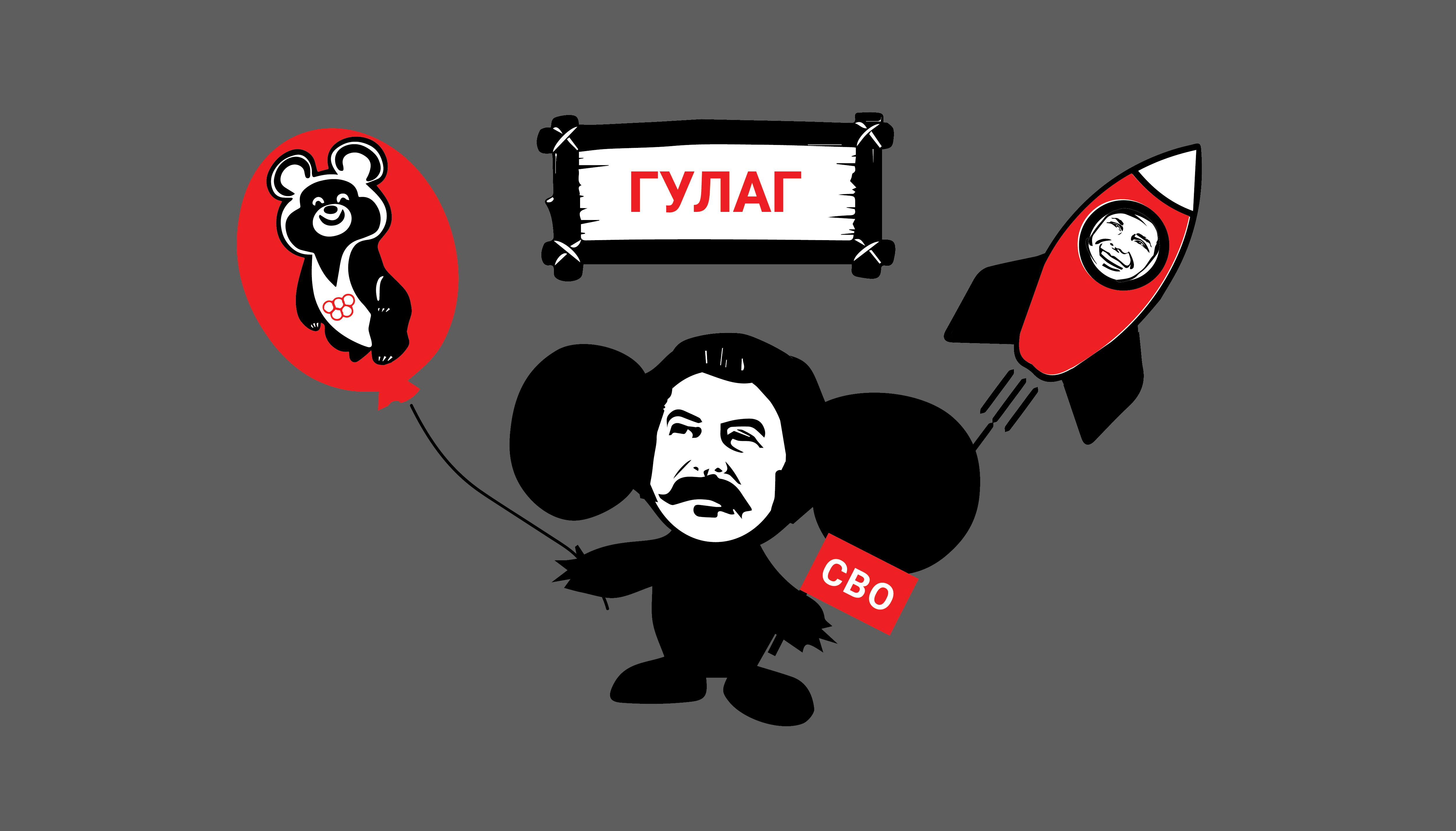Українською читайте тут.
Every year on May 9th, Russia celebrates Victory Day in the Great Patriotic War, organizing military parades and concerts. The “Immortal Regiment” propaganda event, where participants carried banners with images of fallen Red Army soldiers, was canceled in 2023. However, the Russians still decided to hold a military parade.
Nonetheless, even if all May 9th events were canceled, Russian propaganda outlets would still have ample stories about the Soviet era and World War II. Between April 1, 2022, and April 1, 2023, Detector Media recorded nearly 85,600 messages on 295 out of 311 pro-Russian Telegram channels. This means that, on average, each channel publishes a post about the “heroic” Soviet past at least once daily.
Given the volume of messages, this historical period remains significant for the Russian propaganda machine. This is how and why pro-Russian Telegram channels continue discussing it.
To prevent the spread of propaganda, we only quote and name primary sources when absolutely necessary. Data for the analysis of Telegram messages were provided by TeleZip / Mantis Analytics. Keywords used in the TeleZip / Mantis Analytics search engine included: USSR, Warsaw Pact, Soviet Union, victory over Nazism, Red Army, collective farm, collectivization, Victory Day, Cold War, names of Soviet leaders, and the first Soviet cosmonaut Yuri Gagarin. These words were written in Russian.
A poll conducted by the Ilko Kucheriv Democratic Initiatives Foundation in partnership with the Razumkov Center sociological service from December 13 to 21, 2022, revealed that only 12% of Ukrainians negatively assess the Soviet Union’s collapse. In contrast, in Russia, 63% of respondents in January 2023 expressed nostalgia for the USSR. It is worth noting that in May 2020, according to the Kyiv International Institute of Sociology, 33.5% of Ukrainian respondents regretted the USSR’s disintegration. The Ilko Kucheriv Democratic Initiatives Foundation states that in 2023, “Russian missiles eased the longing for the Soviet Union” for one-fifth of Ukrainians.
The Russian propaganda machine depicts the Soviet Union’s collapse as a disaster. Posts from users in the Russian segment of social media frequently express nostalgia for the state that “offers alternatives to capitalist despair.” The territorial integrity and independence of Ukraine and other former Soviet states are portrayed as gifts or mistakes. Significant dates, such as May 9th, when Russia celebrates Victory Day over Nazi Germany, are met with euphoria. Propagandists anticipate Russian leaders announcing a “day of reckoning” for Russia’s enemies.
When propaganda Telegram channels mention the repressions and famines caused by the Soviet Union, they are framed as necessary sacrifices endured by all USSR citizens. Only state leaders are condemned, while direct perpetrators either escape punishment or are even portrayed as heroes and innocent victims. Consequently, the USSR’s crimes are overlooked and replaced with slogans, and collective trauma is substituted with tales of the brighter aspects of Soviet life. As a result, Russian propaganda can denounce Joseph Stalin in some posts and glorify him as a successful statesman in others, even presenting repressions in a positive light.
“Lives of the Saints and Sinners from the USSR”
Propaganda-driven Telegram channels often feature messages about notable events in Soviet history that took place on the publication day. These can include the birthdays or deaths of prominent figures, the inauguration or commencement of construction for specific facilities, anniversaries of battles, space flights, and more. Messages about the event itself are accompanied by assertions that the Soviet Union was a highly advanced and powerful state and its collapse was disastrous as it “disrupted the world’s balance.” Such messages resemble the propaganda technique of “repetition,” where the desired message is regularly repeated, eventually being perceived as truth and avoiding criticism.
The authors of propaganda posts tend to label those they deem responsible for the USSR’s collapse with derogatory epithets. For example, USSR President Mikhail Gorbachev is portrayed as a “Western agent” or mocked as someone who would have made a “great bathhouse manager, but not a national leader.” The leaders of Ukraine, Russia, and Belarus, who declared the end of the USSR and announced the formation of the Commonwealth of Independent States (CIS) in December 1991, are referred to as “three drunks who divided a country that took centuries to unite.”
To “validate” the Soviet Union’s status as a great power, accounts of Russian or Soviet film screenings or reviews in occupied territories are utilized. Cinema also serves as a means of propaganda through “properly” crafted storylines and characters.
Similar to movie characters, true or fictional stories from the lives of Soviet individuals play a comparable role in the propaganda technique of “heroization.” For instance, propaganda Telegram channels tell the tale of boys from the village of Steblove who allegedly “successfully repelled German attacks” in 1941. Another example is the story of Soviet sailors who, in 1960, drifted for 49 days in the ocean on a barge until they reached the shores of the United States, “ate leather belts, boots, leather inserts from an accordion. Collected rainwater... kept watch, shaved, hemmed collars.”. These courageous and resilient heroes who fought the Nazis or confronted the Americans when they drifted into U.S. waters serve as role models.
After occupying foreign territories, Russians introduce their “heroes” associated with these places. “The Melitopol Museum of Local Lore is hosting an exhibition dedicated to the 115th anniversary of the birth of the legendary scout and native of our city, Pavlo Sudoplatov. Pavlo Sudoplatov waged a merciless struggle against Ukrainian nationalists. He personally eliminated the OUN leader Yevhen Konovalets by disguising an explosive device as a box of chocolates, and also conducted an operation to eliminate the SS Hauptmann, one of the leaders of the Nachtigall battalion, Roman Shukhevych,” reported the Telegram channel of the occupation administration of Melitopol in September 2022.
Such messages attempt to impose the occupiers’ worldview on those who consume information from propaganda sources, using significant dates as just one of the reasons to disseminate these narratives.
Enemies as the “Standard of Evil”
The “heroism” of Soviet citizens would be more difficult to promote without vivid depictions of enemies. These enemies often include the USSR’s foes in the German-Soviet and Cold Wars, inhabitants of countries that emerged following the USSR’s collapse, and opponents of modern Russia’s authorities. These enemies typically possess only negative traits, and their actions and ideas are consistently portrayed as wrong and criminal by propaganda.
In contemporary Russian propaganda, the enemies of the USSR serve as the “standard of evil.” New artistic techniques are incorporated into the wording created by Soviet propaganda and repeated in modern Russia: “History has seen this before, only instead of Soviet Dnipro motorcycles, there were German BMWs, and instead of Ukrainian Nazis, there were just Nazis.”
Such generalizations employ the “one opinion” propaganda tactic, helping to promote the idea that Russia has no choice but to battle those whom their state has deemed “evil.”
To reinforce the argument that Russia has no alternative, images of victims that Russia “must protect” are used. For instance, children from occupied territories who are allegedly killed by “Ukrainian Nazis” or forced to sing songs about “Hitler’s henchman Bandera.”
Russian propaganda also portrays the actions of states that gained independence after the USSR’s collapse as threats. For example, the demolition of monuments to Soviet heroes in Ukraine, Lithuania, Latvia, and Estonia is depicted as crimes against the Soviet past and the oppression of the Russian minority in these countries. Moreover, they recommend avoiding the destruction of Russian monuments because the Russians are supposedly coming soon and will “liberate” everyone.
Stalin as a “Mascot”
Stories from Soviet history are also utilized to rationalize, explain, and justify issues within the Russian army. Joseph Stalin frequently served as a role model during the analyzed period. For example, in September, during a successful counteroffensive by the Armed Forces of Ukraine, one message stated: “If Stalin had dismissed and shot commanders and officers for every German counterattack that began, we would have run out of officers in the forty-first.” The message implies that there may be problems in the Russian army, but trust should be placed in the military and the government.
A month later, following an explosion on the Crimean Bridge, the same channel wrote: “Stalin, no matter how monstrous he was, did not stoop to this and tell us that we had lost nothing and there were no problems. For him, the panickers were those who cowardly ran away and ‘withdrew troops’.”
In early 2023, Russia’s Security Council Deputy Head, Dmitry Medvedev, quoted Stalin in a Telegram post. Another pro-Russian Telegram channel reported that the Russian people have a demand for Stalin: “Stalin is such a pinnacle in national mythology that by offering people (and yourself) such a standard, it is very easy to terribly disappoint people.”
At the same time, an occupation Crimean Telegram channel wrote that the granddaughter of a veteran who had allegedly fought for Sevastopol longs for Stalin’s leadership. Her grandfather allegedly disapproved of the “soft-bodied” Soviet leaders who came to power after Stalin’s death. Such messages are conveniently used to justify Russian repressions in occupied territories, employing the “third party” propaganda tactic.
Soviet Can Be Bad if It Is Ukrainian
There are positive reviews of Soviet equipment used by Russian troops on Telegram: “The soldiers are hitting enemy positions from a distance of 5.5 km and praise the work of intelligence and the quality of weapons. The S-60 is a Soviet anti-aircraft artillery system that uses 57 mm caliber AZP-57 anti-aircraft guns, which were put into service in 1950.”
The same applies to objects built in the USSR. For example, if a bridge is damaged due to hostilities, Russian Telegram channels will write that the bridge survived because it was built during the USSR era.
However, when Ukrainians use or receive Soviet equipment from their partners, such news becomes an opportunity to practice propaganda tactics of devaluation: “They are giving away all their old equipment to Kyiv.”
Pro-Russian Telegram channels tend to suppress most negative information about the Soviet Union. After all, industrialization was accompanied by repression, collectivization coincided with famine, and accessible food was not always available. Mass celebrations of Victory Day only began in 1965, and prior to that, they were limited to military displays and controlled press publications. Nonetheless, in contemporary Russia, the Soviet Union is regarded as a desirable model of a state.



